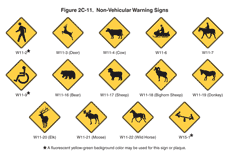

Warning signs are used to alert highway, street or road users to unexpected or dangerous conditions ahead that might call for a reduction of speed, situations that might not be readily apparent, or an action in the interest of safety and efficient traffic operations such as a curve, detour, sideroad, etc.
Neonates and young infants often present with non-specific symptoms and signs that indicate severe illness. These signs might be present at or after delivery or in a newborn presenting to hospital or develop during hospital stay. The aim of initial management of a neonate presenting with these signs is stabilization and preventing deterioration. The signs include:
- The current article addresses the issue of warning signs for suicide, attempting to differentiate the construct from risk factors. In accordance with the characteristic features discussed, a consensus set of warning signs identified by the American Association of Suicidology working group are presented, along with a discussion of relevant clinical and research applications.
- Made in the USA, with a huge selection of stock products and endless custom capabilities, Safehouse Signs is the place for of all your sign needs. Danger Signs – Page 36 – Safehouse Signs Home.
- not feeding well
- convulsions
- drowsy or unconscious
- movement only when stimulated or no movement at all I fast breathing (60 breaths per min)
- grunting
- severe chest indrawing
- raised temperature, > 38 °C
- hypothermia, < 35.5 °C
- central cyanosis?
#36: Danger Signals Adventures in Odyssey Children's Music 2001 Preview Buy for $17.99 SONG TIME 462: The W.E. 24:09 PREVIEW 463: Green Eyes & Yellow Tulips. Buy Danger Signal Movie Poster (14 x 36 Inches - 36cm x 92cm) (1945) Insert Style B -(Faye Emerson)(Zachary Scott)(Richard Erdman)(Rosemary DeCamp)(Bruce Bennett): Posters & Prints - Amazon.com FREE DELIVERY possible on eligible purchases.
Emergency management of danger signs:
- Open and maintain airway. Give oxygen by nasal prongs if the young infant is cyanosed or in severe respiratory distress or hypoxaemic (oxygen saturation < 90%).
- Give bag and mask ventilation with oxygen (or room air if oxygen is not available) if there is apnoea, gasping or respiratory rate too slow (< 20).
- Insert venous cannula.
- Give ampicillin (or penicillin) and gentamicin (see below).
- If drowsy, unconscious or convulsing, check blood glucose. If glucose < 2.2 mmol/l (< 40 mg/100 ml), give 10% glucose at 2 ml/kg IV. Then give a sustained IV infusion of 5 ml/kg per h of 10% glucose for the next few days while oral feeds are built up.
If you cannot check blood glucose quickly, assume hypoglycaemia and give glucose IV. If you cannot insert an IV drip, give expressed breast milk or glucose through a nasogastric tube.
- Give phenobarbital if convulsing
- Admit
- Give vitamin K (if not given before)
- Monitor the infant frequently.
Neonates and young infants often present with non-specific symptoms and signs that indicate severe illness. These signs might be present at or after delivery or in a newborn presenting to hospital or develop during hospital stay. The aim of initial management of a neonate presenting with these signs is stabilization and preventing deterioration. The signs include:

- not feeding well
- convulsions
- drowsy or unconscious
- movement only when stimulated or no movement at all I fast breathing (60 breaths per min)
- grunting
- severe chest indrawing
- raised temperature, > 38 °C
- hypothermia, < 35.5 °C
- central cyanosis?
Emergency management of danger signs:
36: Danger Signals Meaning
- Open and maintain airway. Give oxygen by nasal prongs if the young infant is cyanosed or in severe respiratory distress or hypoxaemic (oxygen saturation < 90%).
- Give bag and mask ventilation with oxygen (or room air if oxygen is not available) if there is apnoea, gasping or respiratory rate too slow (< 20).
- Insert venous cannula.
- Give ampicillin (or penicillin) and gentamicin (see below).
- If drowsy, unconscious or convulsing, check blood glucose. If glucose < 2.2 mmol/l (< 40 mg/100 ml), give 10% glucose at 2 ml/kg IV. Then give a sustained IV infusion of 5 ml/kg per h of 10% glucose for the next few days while oral feeds are built up.
If you cannot check blood glucose quickly, assume hypoglycaemia and give glucose IV. If you cannot insert an IV drip, give expressed breast milk or glucose through a nasogastric tube.
36: Danger Signals Online
- Give phenobarbital if convulsing
- Admit
- Give vitamin K (if not given before)
- Monitor the infant frequently.